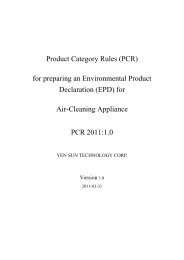Download(PDF) - PCR Library
Download(PDF) - PCR Library
Download(PDF) - PCR Library
You also want an ePaper? Increase the reach of your titles
YUMPU automatically turns print PDFs into web optimized ePapers that Google loves.
• Production of raw materials (specific and/or average background)<br />
• Manufacturing of the product (specific)<br />
• The mix of electricity used should be the official one in the country where main energy<br />
consuming processes take place, if site-specific data cannot be obtained. The mix of<br />
electricity (calculation procedure) shall be documented.<br />
• Hazardous waste shall be specified according to relevant regulation (e.g. EU Directives<br />
91/689/EEC and 75/442/EEC (specific and/or average background))<br />
4.5 Cut-off rules<br />
Any processes or activities that altogether do not contribute to more than 2 % of the total mass<br />
and 1 % of the total energy use may be omitted from the inventory analysis. However, omissions<br />
of any material flows that may have a relevant contribution to the selected impact categories of<br />
the products underlying the EPD shall be justified, if applicable by a sensitivity analysis.<br />
A list of hazardous and toxic materials and substances shall be included in the inventory and the<br />
cut-off rules do not apply (relevant regulations).<br />
4.6 Data Quality requirements<br />
4.6.1 Allocation rules<br />
In a production process where more than one type of product is generated, it may be necessary to<br />
allocate the environmental impacts (inputs and outputs) from the process to the different products<br />
in order to get product-based inventory data.<br />
In principle allocation rules should reflect the goal of the production process. For production of<br />
windows and doors the primary allocation rule is that allocation shall be carried out according to<br />
mass.<br />
Raw material energy shall be allocated to material resources (kg), while process energy shall be<br />
allocated to energy resources (MJ).<br />
When the product’s original function is lost, it can be processed further in a waste management<br />
system, e.g. it can be recycled and/or reused and energy recovered.<br />
The recycling processes shall be treated as closed loop recycling, as long as no changes occur in<br />
the inherent properties of the recycled material. In such cases, the need for allocation is avoided<br />
since the use of secondary material displaces the use of virgin (primary) materials. Recycled<br />
materials that are used in the fabrication of the product shall have no environmental impact on the<br />
new product.<br />
The environmental impacts from recycling are allocated to the product they come from according<br />
to mass.<br />
When allocation is used, the economic reality and other relevant aspects shall be considered to<br />
determine if other allocation criteria would be more appropriate or lead to deviating results. A<br />
sensitivity analysis should be initiated if a deviation of > 20% is foreseen.<br />
Different data sets shall be documented and reported, if different allocation options are relevant.<br />
N<strong>PCR</strong> 014 Windows and doors April 2009 side 8 av 17















